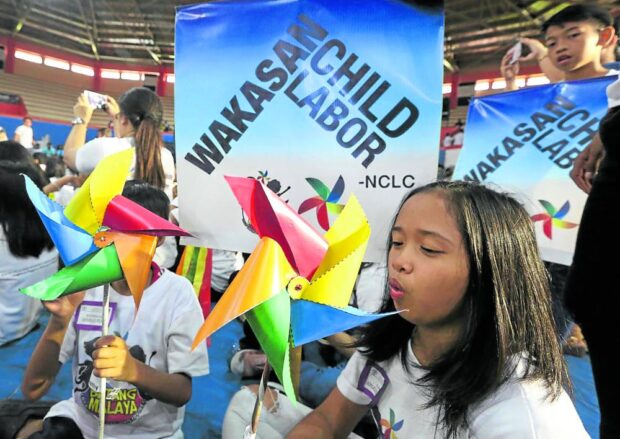
SPARE THE YOUNG ONES | A program held at San Andres Gym in Manila marked World Day Against Child Labor, in this photo taken on June 23, 2018. (File photo by MARIANNE BERMUDEZ / Philippine Daily Inquirer)
MANILA, Philippines — The number of Filipino child laborers — or those aged 5 to 17 who are forced into exploitative or harmful work — declined in 2022, according to the Philippine Statistics Authority (PSA).
In its latest situation report on employed minors dated July 25, the PSA estimated there were 828,000 Filipino child laborers last year, accounting for 56 percent of the 1.48 million total “working children” in the country in 2022.
Under the country’s labor laws, minors age 15 to 17 can be legally employed—but only within a safe, limited range of jobs—and are referred to as “working children.” They are distinguished from “child laborers,” or those who are illegally forced to do dangerous work in exploitative conditions.
The PSA report cited an 11.44-percent decline from the 935,000 child laborers in 2021, accounting for 68.4 percent of the 1.37 million estimated working children that year.
According to the PSA, a child aged 5 to 17 years old is considered working if he or she had a job or business or worked either paid or unpaid in the family farm or business.
The Department of Labor and Employment (Dole) has pegged the minimum employable age at 15, so minors who are at least 15 years old but below 18 are legally allowed to work, provided they are not engaged in child labor.
Hazardous work
Child labor is defined as any work or economic activity performed by a child that subjects him to any form of exploitation or is harmful to his health and safety, physical, mental or psychosocial development, according to Dole. It is also defined as hazardous work, often done for long hours (or more than 40 hours per week), at nighttime or the entire day.
The PSA data showed that the vast majority of the country’s child laborers, at almost seven of every 10, are in the agriculture sector; with 25.9 percent in services, and 5.3 percent in the industry sector.
About 13 in every 100 child laborers are in Soccsksargen, which had the highest child labor share at 12.3 percent; followed by Calabarzon at 11.1 percent; Central Visayas at 10.5 percent; Northern Mindanao at 8.8 percent and Bangsamoro Autonomous Region in Muslim Mindanao at 7.7 percent.
The majority, or 66.2 percent, of 548,000 child laborers were boys, although the percentage of girls has been steadily increasing from 27.2 percent in 2020 to 33.8 percent in 2022.
Not for minors
Dole has declared the following as hazardous work for minors: mining and quarrying; construction; transportation and storage; water supply, sewage and waste management; forestry and logging; fishing and aquaculture; hunting and trapping; security and investigation; manufacture of alcoholic beverages, tobacco, pyrotechnics, rubber and plastic products, chemicals and chemical products, basic metals, and weapons and ammunition.
The labor department has also declared the following as hazardous occupations for minors:
- farming; animal production
- sciences and health work with tasks that involve radiation-emitting machines, laboratory equipment, human or animal blood, fecal remains, and other body fluids or chemicals
- occupations requiring the use of power tools and toxic substances
- selling of alcohol, tobacco, pyrotechnics, and chemicals
- courier and delivery-related tasks that expose the child to road accidents and heavy loads
- personal and protective services that involve dangerous tour guide activities
- care of persons with communicable diseases
- housekeeping-related tasks that require the use of power instruments and handling toxics, bartending, cooking with pressurized cookers
- work exposed to sexual abuse
- customer services and work in gambling facilities
- craft and trade work that involve operating high-power machines, sanding, varnishing, painting
- tasks related to textiles and garments
Up since pandemic
The PSA report noted, however, that the number of Filipino working children has increased since the pandemic.
In 2020, the number of working children age 5 to 17 years old was estimated at 872,000 which was a mere 2.8 percent of the 31.17 million minors in that age group that year.
This shot up to 1.37 million in 2021, which was 4.3 percent of the total 31.64 million minors age 5 to 17 years old.
This further rose last year to 1.48 million working children, or 4.7 percent of the 31.71 million total minors age 5 to 17 years old.
About half, or 49.5 percent of the working children in 2022, were in the services sector, which is higher compared to the 45.4 percent and 43.4 percent share in 2021 and 2020, respectively.
The majority, or 59.7 percent of the working children last year, were 15 to 17 years old.
There were also more boys than girls among the working children. Of the 1.48 million working children in 2022, 868,000, or 58.7 percent, were boys while 610,000, or 41.3 percent, were girls.